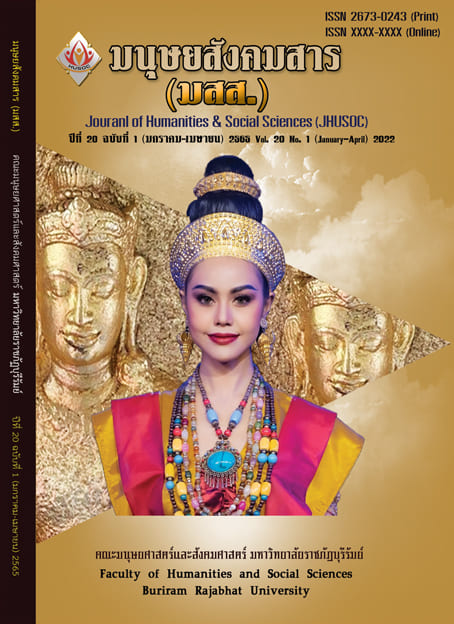Community Participation Network Guidelines for Water Hyacinth Removal in Khlong Rangsit Pathum Thani
Main Article Content
บทคัดย่อ
This study proposes the guidelines for community participation network focusing on water hyacinth removal and leveraging such aquatic weeds in Khlong Rangsit, Pathum Thani province. The methodology used in this study is of qualitative research and the samples are 8 associates related to water hyacinth removal at Bung Ba swamp, Nong Suea District, Pathum Thani Province, selected among community leaders, locals and private and government sectors agents. Semi-structured interview is constructed as the research instrument; in-depth interviews data collecting and content analysis. The consequences regarding knowledge and insight on water hyacinth removal and community participation highly rely on estimated fund, instruments and methodology which require attentive planning and agreeable collaboration from all sectors.
Article Details

อนุญาตภายใต้เงื่อนไข Creative Commons Attribution-NonCommercial 4.0 International License.
เนื้อหาและข้อมูลในบทความที่ลงตีพิมพ์ในวารสารทดสอบระบบ ThaiJo2 ถือเป็นข้อคิดเห็นและความรับผิดชอบของผู้เขียนบทความโดยตรงซึ่งกองบรรณาธิการวารสาร ไม่จำเป็นต้องเห็นด้วย หรือร่วมรับผิดชอบใดๆ
บทความ ข้อมูล เนื้อหา รูปภาพ ฯลฯ ที่ได้รับการตีพิมพ์ในวารสารทดสอบระบบ ThaiJo2 ถือเป็นลิขสิทธิ์ของวารสารทดสอบระบบ ThaiJo2 หากบุคคลหรือหน่วยงานใดต้องการนำทั้งหมดหรือส่วนหนึ่งส่วนใดไปเผยแพร่ต่อหรือเพื่อกระทำการใดๆ จะต้องได้รับอนุญาตเป็นลายลักอักษรจากวารสารทดสอบระบบ ThaiJo2 ก่อนเท่านั้น
เอกสารอ้างอิง
Bung Ba Subdistrict Administrative Organization. (2021). Bung Ba Subdistrict administrative organization. from http://bungba-sao.go.th/ [in Thai]
Chairit, A., Sinthorngo, A., & Khunkha, N. (2020). Community participation guidelines on issues regarding water hyacinth in Theppharat
Subdistrict, Ban Pho District, Chachoengsao Province. Journal of Local Governance and Innovation, 4(2), 35-50. [in Thai]
Institute of Thai Studies, Chulalongkorn University. (1994). 100 years of Khlong Rangsit: The Pilot Experiment Commemorating His Majesty’s Golden Jubilee. Institute of Thai Studies, Chulalongkorn University. [in Thai]
Ngarmwitroj, B., Chareonphansoon, S., Kuruwut, T., & Samerkham, P. (2012). The
management of water hyacinth in drainage basins. Bangkok: Bureau of Research, Development and Hydrology. Department of Water Resources. [in Thai]
Phukhajorn, P. (2003). Using water hyacinth resin for dye removal in dyed wastewater. Thesis for Master of Public Health Program in Environmental Health. Khon Kean: The Graduate School of Khon Kaen University.
[in Thai]
Prakongwong, C. (1991). The growth of water hyacinth in Makkasan Swamp. Bangkok. Department of agriculture. Central laboratory and greenhouse complex. Water hyacinth. http://clgc.agri.kps.ku.ac.th/resources/weed/ eichornia.html [in Thai]
Regional Environmental Office 5. (2011). Water hyacinth removal guidelines. Nakhon Prathom: Regional Environmental Office 5. [in Thai]
Sa-yam, S., Nopnattawongsakorn, R., & Srithongrung, R. (2018). Management of water hyacinth in the public water source sustainably: A case study of Nong Phrao Ngai Sub-district administrative organization, Sainoi District, Nontaburi Province. Political Science and Public Administration Journal: Rajabhat Maha Sarakham University, 3(1), 75-107. [in Thai]
The Pathum Thani Provincial Office. (2020). Development plan of Pathum Thani for 2018-2022 (Revised). Pathum Thani: The Pathum Thani Provincial Office. Strategy and Data Development Division. [in Thai]
Urban Development Training Institute. (2018). Strategic issues and mechanical knowledge management. Press Creation Company, Bangkok. [in Thai]
Weerapattananirand, P. (1999). Community learning management. http://www.banrainarao.com/column/learn_commu [in Thai]


